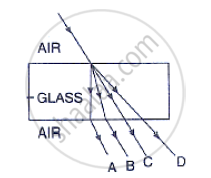Advertisements
Advertisements
प्रश्न
An object 50 cm tall is placed on the principal axis of a convex lens. Its 20 cm tall image is formed on the screen placed at a distance of 10 cm from the lens. Calculate the focal length of the lens.
उत्तर
Height of object (h) = 50 cm
Height of image (h') = -20 cm (real and inverted)
Distance of image from the lens (v) = 10 cm
Distance of object from the lens (u) = ?
Focal length of the lens (f)= ?
We know, magnification (m) of the lens is given by:
m=`v/u=(h')/h`
Thus, substituting the values of v, h and h', we get:
`10/u=(-20)/50 `
`10/u=(-20)/50`
`u=(-5)/2x10`
∴ u=-25 cm
Using the lens formula:
`1/v-1/u=1/f`
`1/10-1/-25=1/f`
⇒`1/10+1/25=1/f`
⇒`(5+2)/5=1/f`
⇒`7/50=1/f`
⇒`f=50/7`
⇒`f=7.14`cm.
APPEARS IN
संबंधित प्रश्न
A beam of light travelling in a rectangular glass slab emerges into air. Draw a ray-diagram indicating the change in its path.
A beam of light travelling in air is incident of water. Draw a ray-diagram indicating the change in its path in water.
Distinguish between a convex lens and concave lens. Which of the two is a converging lens : convex lens of concave lens?
Find the position and nature of the image of an object 5 cm high and 10 cm in front of a convex lens of focal length 6 cm.
An image formed on a screen is three times the size of the object. The object and screen are 80 cm apart when the image is sharply focussed.
State which type of lens is used.
In figure , name the ray which represents the correct path of light while emerging out through
a glass block.

The focal length of a thin convex lens is ______ than that of a thick convex lens.
A converging lens forms the image of an object placed in front of it, beyond 2F2 of the lens. Draw a ray diagram to show the formation of the image.
Write the three characteristics of the image formed by a convex lens of focal length 20 cm for the object at distance (i) 10 cm, (ii) 30 cm, (iii) 40 cm, (iv) 60 cm from the lens.
Distinguish between Concave lens and Convex lens.
